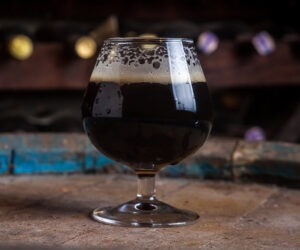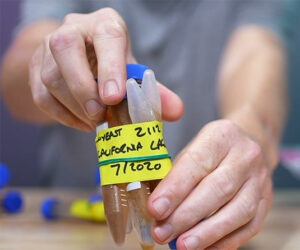Brewing with Brett: Tips from the Pros
Brewer: David Logsdon, Logsdon Organic Farmhouse Ales in Hood River, OR
The methods of brewing with Brettanomyces weren’t really established; they were created more by default as Brettanomyces found its way into beer more so than being introduced. That’s why it’s considered a wild fermentation. First, brewers got spontaneous fermentation in styles like lambics and English porters, then came controlled inoculation, primarily in secondary fermentation, or purposeful inoculation to affect the flavor profile.
There are four different species of Brettanomyces commonly found in beer: lambicus, bruxellensis, claussenii, and anomalus. Some produce better flavors than others. They’re not all the same by any imagination.
Brett adds fruitiness to beers in addition to a high acidity taste, and it can have a pretty incredible impact of keeping the freshness more intact and delaying degradation of the beer, while enhancing the beer at the same time. Brett beers will evolve, as a little bit of fermentation takes place you get new esters that form in the bottle; that’s one of the things that is nice about a refermented bottle. In addition to creating new esters and flavor compounds in the bottle while aging, what it’s also doing is re-esterification where esters break down and form new esters. There are many good things happening in that beer over time. It is getting dryer, you do lose some esters, but other things are going on to supplant what was there and it evolves well.
Some people are doing 100 percent Brett beers, which I have not tried because I have not personally found 100 percent Brett beers to be all that desirable flavor-wise. When brewing a 100% Brett beer, many brewers will wait 6 to 12 months in fermentation. We add Brett in secondary (after adding Saccharomyces in primary) and with the strains we use we give it two weeks conditioning and we see the pellicle forming, pH dropping, and flavor development occurring. At that point the beer is distinct and very flavorful.
We make our Seizoen with Saccharomyces yeast for primary fermentation and a Seizoen Bretta that has the addition of our unique strand of Brett, in which the matiness drops out of it. It can almost seem sweeter because of the fruitiness but it is dryer because the malt is not prevalent and the Brett tends to eat up a lot of hop flavors as well, however the bitterness remains constant.
Some brewers are really paranoid about bringing Brett into their brewery, or any yeast that is not their brewing strain. In my 25 years of experience, I can say Brett should not be feared— contamination should not be an issue for people with a normal cleaning and sanitation regiment.
My advice for anyone who wants to brew with Brett is to experiment with some different strains. Try a few different things, and try to manage the yeast and have a big enough cell count to get you a good start. The other important thing is to have patience and continue evaluating your brew over time. It might take a year to get your head wrapped around it and get your beer moving in a direction you want it to.
Brewer: Gabe Fletcher, Anchorage Brewing Co. in Anchorage, AK
I use Brettanomyces because I love how versatile it is. Brett can adapt to almost any situation and almost thrives under stress, plus it has a huge range of flavor when fermented in different ways. The other big benefit is its shelf-life stability. You can make a super hoppy Belgian DIPA and the Brett will continue to live in the bottle, absorbing any oxygen that is left from the brewing process. After two years the hop flavor is still fresh and there is no cardboard character from the hops oxidizing. Eventually the hops die down, but instead of the beer going stale, the Brett flavors come to the forefront and you have a whole different experience to enjoy.
Most of my beers have three different yeast in three different fermentations. I use a Belgian strain for primary fermentation in foundres, and then I secondary with Brett (usually bruxellensis from Wyeast) in small barrels. Lastly, I bottle condition, usually with wine yeast. I have found that layering the flavors from all the different fermentations adds a real depth to the beers.
In addition to bruxellensis, I have several other Brett stains in the brewery as well, including some from Chad Yakobson at Crooked Stave in Denver, Colorado. Shaun Hill (brewer at Hill Farmstead in Greensboro, Vermont) and I just brewed a Saison at the brewery using a couple of those strains mixed with some Saison strains that turned out really nice.
Brewing Brett beers is not very different than traditional beers. When I’m making a beer that will spend a long time in barrels I do a higher mash temp, around 158 °F (70 °C), to add more dextrins to the wort so the Brett has something to chew on during it’s long fermentation phase. For beers with a shorter time in barrels, I do a low mash temp, around 146 °F (63 °C), and I won’t go over 13 °Plato for the starting gravity. That way the primary yeast can take care of most of the sugars before the Brett comes into play, allowing a shorter fermentation time for the Brett.
I only make Brettanomyces beers, so cross contamination is not an issue. If you work in a brewery that produces non-Brett beers also, then there are added challenges. The most important thing in that situation is to have separate process parts for the Brett beers, i.e. anything that is not stainless steel. You can use the same tanks, just make sure you change all of the gaskets and hoses out. Another big challenge is bottle conditioning. If you are aging the beer for several months in a tank or barrel it is easier because the Brett has time to ferment out all of the non fermentable sugars the regular yeasts couldn’t — reducing the risk of having the bottles blow up after a few months because there was a lot more sugar in the bottle then you thought. If you do want to bottle condition with the Brett, then I would suggest adding the Brett to the tank at the end of fermentation so it has some time to ferment in the tanks to make the beer dryer. I wouldn’t bottle a Brett beer that was higher then 0.8 to 1 °Plato in gravity. Anything higher than that and you will have too much left over sugar for the Brett to eat later on, which will result in over-carbonated beer. Just to give you an idea, it only takes about 0.5 degrees Plato of sugar to carbonate to 2.5 volumes of CO2. So if you bottled at 1.5 °Plato and then added enough sugar for 2.5 to 3 volumes of CO2, after about 5 months or so you might end up with 5 volumes of CO2! That’s a lot! In the past, I have stopped the fermentation at 2.5 °Plato by cooling it, then I bottle the beer with no sugar added. It takes a little longer to ferment in the bottle, but you end up with nice carbonation and no issues with over-carbonation.
To homebrew your Brett beer, start with making your favorite Belgian-style recipe. Let it ferment out in the carboy, transfer to another carboy, add a couple smack packs of Brett, and just let it sit for 6-8 months. Don’t disturb the pellicle that will grow on the top of the beer, that’s what protects the beer from oxidation during the aging process. It looks like mold on the top of the beer if you have never seen one before, it’s a good thing, so don’t dump it! After the 6-8 months, transfer it off the pellicle and bottle condition with a Belgian or wine yeast culture. Give it 3-4 weeks in the bottle and then enjoy. I would leave some out warm for another 3 months and see how it develops.



